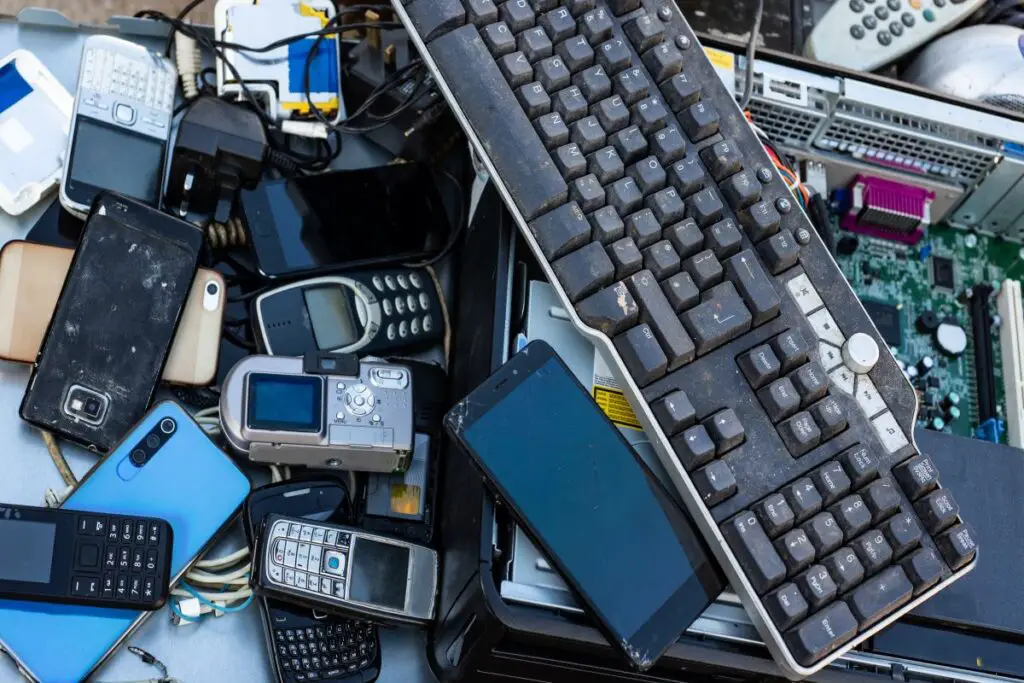Cell phones and other electronic devices do not just vanish. They either stay inside homes or in landfills. In the long run, they can cause problems for both humans and the environment. So, what should you do with them? More importantly, can electronic devices be recycled?
You can recycle all electronic devices that are primarily metal-made and with a power cable or on/off switch. You can either send them to an authorized recycler or get them straight to electronics shredding.
Read on to learn more about the whole process of recycling electronics. But first, let’s discuss what it means to recycle electronic devices.
Quick Navigation
- What Does “Recycling Electronics” Mean?
- Is It OK To Throw Away Electronic Materials?
- The Importance Of Recycling Electronics
- What Types of Electronics Can You Recycle?
- 9-Step Guide To Electronics Recycling
- Electronics Recycling Practices
- Conclusion
What Does “Recycling Electronics” Mean?
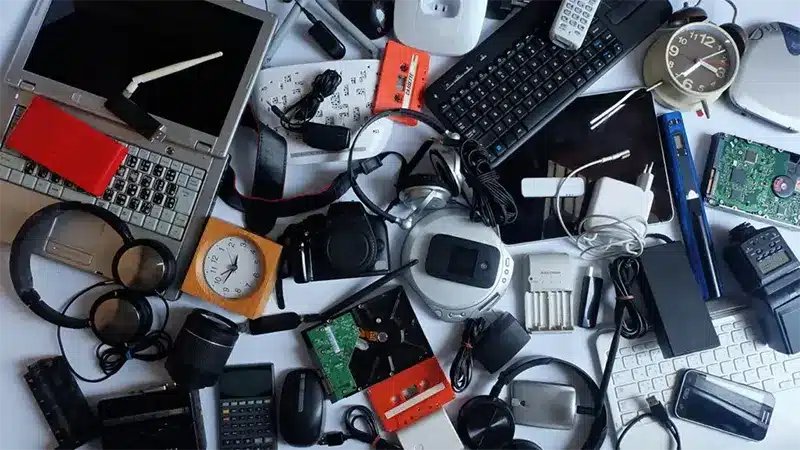
Electronic waste, or e-waste, refers to unwanted, non-working, outdated, or expired electronics. Electronics recycling, meanwhile, is the process of gathering, sorting, and recycling the electronics’ salvageable components. Reusing items extends their useful life and is always better for the environment.
This procedure aims to safeguard the environment from potentially harmful substances that may wind up in landfills and leak into the air, soil, and water.
Additionally, discarding outdated equipment helps to erase any sensitive personal or company data. Thanks to this, companies are safe against information leaks, identity theft, and data breaches.
Where are electronics recycled? You may adequately recycle electronics at a reputable local electronics recycler. Users may choose their state and city on the E-cycling website to locate a reputable recycler nearby.
Numerous electronic recyclers also provide pick-up and collecting services. There are various recycling programs from many respectable recycling companies.
What Happens When Electronics Are Recycled?
What truly transpires to your damaged or old gadgets when you give them to a recycler?
Depending on the state of your electronics and the cost, one of a few things may occur. Electronics recyclers can sometimes repair and sell goods that are still usable.
Recyclers disassemble these electronics so the constituent components may be sorted by type when that isn’t possible or cost-effective.
For instance, recyclers will separate ferrous and non-ferrous metals during sorting. These parts may be processed and supplied to manufacturers after separating them.
Parts that they can’t recycle effectively, such as plastic switches and housing, might eventually wind up in a landfill.
Is It OK To Throw Away Electronic Materials?
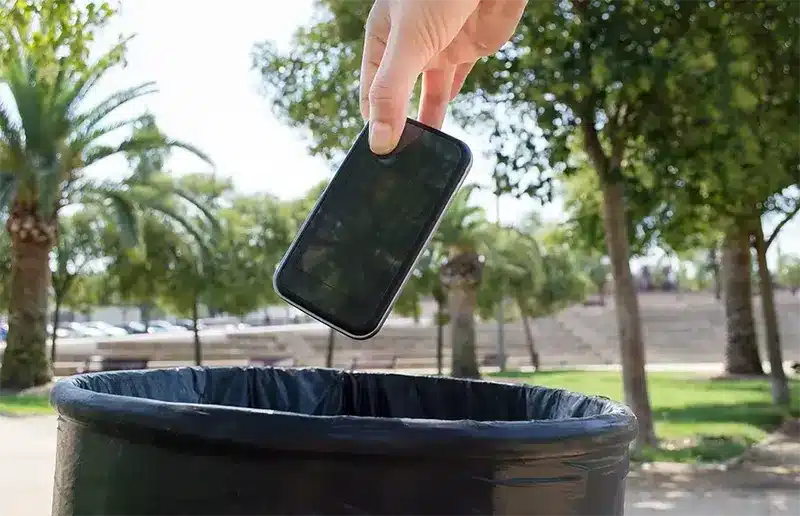
You cannot undo the carbon footprint left by a single electronic device. Your computer and monitor may take thousands of years to break down in a landfill. Meanwhile, harmful compounds, like the cadmium often found in chip resistors and wires, might seep into the soil and groundwater.
It would be best if you refrained from disposing of your electronic waste in the garbage because:
- You could violate the law
- You may detect dangerous chemicals in e-waste
- There are resources accessible for electronic recycling
The Importance Of Recycling Electronics
Keeping materials like mercury, cadmium, and arsenic out of landfills is in everyone’s best interest since they might wind up in the soil and groundwater and cause health issues for nearby residents.
Depending on where you reside, your only choice for legally handling the e-waste generated by your company may be to donate or recycle gadgets.
Recycling electronics has a crucial sustainability component as well. Recovery of valuable materials from worn electronics reduces the need to dig for virgin resources, similar to other forms of recycling.
Precious metals, which are costly, challenging to mine, and highly recyclable, are often used in electronics.
According to the EPA, approximately thousand pounds of copper, silver, gold, and palladium are attainable in 1 million recycled mobile phones.
Why Should You Recycle or Fix Your Electronics?
In general, you shouldn’t just be worried about glass bottles and plastics. Electronic garbage is actually the fastest-growing waste stream worldwide. Our electronics have a shorter lifetime, and society wants the latest high-tech gadgets.
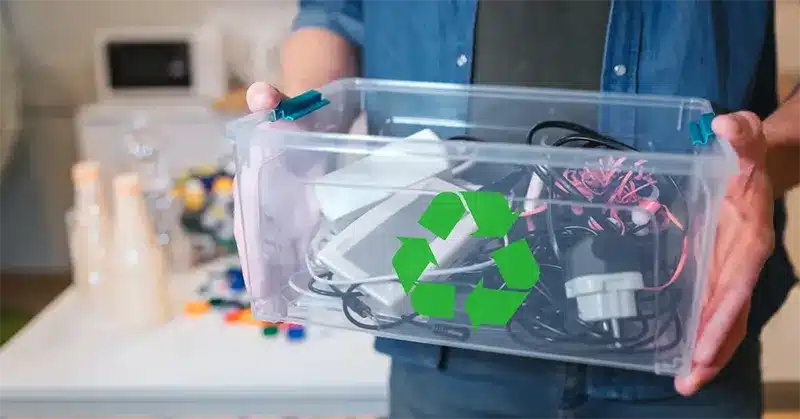
The EPA estimates that about 25% of e-waste undergo recycling. The rest is in landfills, incinerators, or illegally transferred to developing countries.
Most electronic parts include lead acid, beryllium, polyvinyl chloride, and mercury, making this harmful. These are very hazardous wastes. Properly recycling gadgets is crucial.
Zero waste rules or sustainable waste management offers a variety of advantages in addition to helping counteract the adverse effects of trash. E-waste recycling on a wide scale is crucial since current e-waste management needs to keep up with our demand.
What Types of Electronics Can You Recycle?
Since most used electronics are composed chiefly of metals, you can recycle them to some extent.
In general, recyclable electronics include:
- cell phones
- desktop computers
- tablets
- printers
- scanners
- TVs
- cameras
- audio and video equipment
- power tools
- lights
- circuit boards
- electronic toys
- appliances like microwaves, toasters, and ovens
- other smart devices
Your company could employ various recycling bins in the workplace, depending on your industry. Only a few specific kinds of electronics cannot be properly recycled.
9-Step Guide To Electronics Recycling
Now you know what electronics recycling is and what kinds of electronics may be recycled. Read on to learn each stage in the recycling process.
Step 1: Gather Unused Electronics
You can find unused and outdated electronics wherever technology is utilized, including at home, work, schools, hospitals, industrial sites, etc.
Step 2: Deliver Electronics To An Authorized Recycler
Transporting electronic products to a recognized electronics recycler is one of the most crucial parts of the process. If you have a lot of heavy electronics to recycle, many recycling facilities will arrange transportation services to come and pick up the gadgets for you.
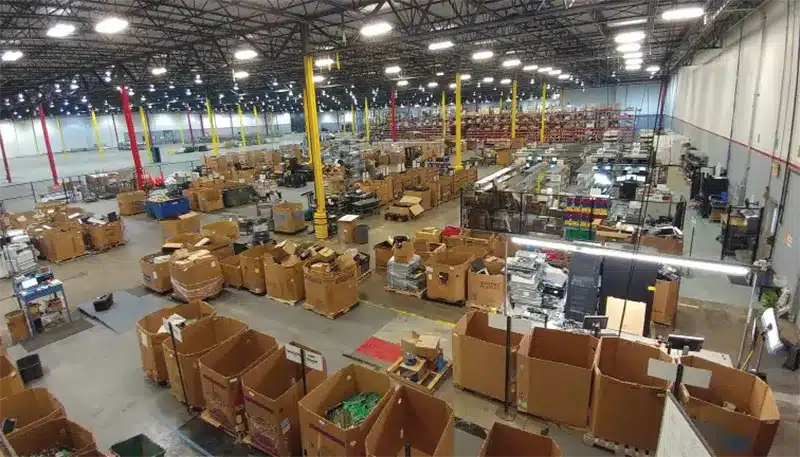
In the United States, there are two standards for recycling electronics. The recycler must complete and maintain certification processes for each standard.
The first is the Responsible Recycling (R2) Practices, and the second is the e-Stewards Standard for Recycling and Reusing Electronic Equipment.
Step 3: Electronics Shredding
Recyclers destroy these gadgets once they are at the recycling center. The shredding procedure is often manual since they thoroughly disassemble and scrutinize each electronic item. Then, they’ll proceed with categorizing them piece by piece after disassembling.
Step 4: Sorting
Why aren’t the electronics separated first and then destroyed? The shredding procedure must begin first since it is necessary to separate the various parts of the electronic item.
You may find various materials, polymers, chemicals, and others in a specific device. It is necessary to disassemble the electronics before sorting and recycling.
Before the items continue in the recycling process, recyclers separate dangerous materials (such as cathode ray tubes) at this phase.
Step 5: Dust Removal
Dust extraction puts the remaining electronic parts on a conveyor belt. The pieces are spread out and shaken on the belt, after which dust is collected and discarded.
Step 6: Magnetic Separation
After the dust removal, the ferrous and non-ferrous metals will be magnetically separated. Large magnets are employed in this phase to separate iron and steel from other materials by sucking them up. This step is crucial since metal and plastic recycling must be separate.
Step 7: Water Separation
Water separation happens after the magnets separate metal from other materials. Hydraulics safely and effectively separate glass from plastic in this process. Glass is recycled differently from plastic and metal.
Step 8: Purification
The waste is then analyzed to ensure that all components are broken down and recycled correctly.
For example, if the electronics recycling facility can melt down valuable metals on-site, they would often analyze the components and remove any corrosion, paint, or other substances that may be present in the metal. The metal may then be heated and refined more effectively.
Step 9: Ready For Resell

When the electronics are in their most basic components, each one is transported and sold to other facilities that can reuse or recycle them inside the same facility according to its category (metal, plastic, paper, glass, etc.).
Electronics Recycling Practices
Here are some standard practices for recycling electronics:
1. Do not place small electronics in curbside recycling containers. They often include glass parts that may break if devices were to be thrown into a truck and then covered with other recyclables.
This way might risk recycling workers’ safety and contaminate other recyclables in the same shipment.
2. Be careful to remove all your data from the computer or phone before recycling it or giving it away. Only dispose of or sell old gadgets that can’t keep that information, such as tools, computer monitors, and home appliances.
Anything with a hard drive could still store private data about your company, its personnel, or its clients. New, tech-savvy owners may recover the pictures.
3. Remove batteries from gadgets before recycling. Lithium-ion batteries are one noteworthy exception; you may return them to the company that made them. Never dispose of nickel-cadmium batteries in the trash!
They contain toxic chemicals that might damage our natural resources. To locate a nearby disposal facility, try searching on a website like Battery Recyclers of America.
You might be interested to learn about the Rodin Coil, a fascinating device known for its unique geometric patterns.
Conclusion
The quantity of trash that needs handling locally and worldwide may decrease by sustainably managing electronics through repairing and recycling.
You may be able to sell your used gadgets straight to a recycler. Calling your recycling provider is the best method to assess your unique alternatives. If you have any outdated devices that might contain mercury or lead and need further information on how to manage them.

